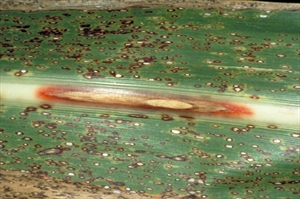- Worldwide distribution. On sugarcane, maize and sorghum, crop relatives and wild species. Important fungal disease.
- Infections through nodes and wounds. Large red external patches, and internal rots with white spots at right angles to stem. Leaves yellow, dry and die.
- Spread in setts, and by water-splashed spores.
- Cultural control: setts only from healthy fields; avoid planting in dry or wet times; treat setts in hot water (50°C for 2 hours); avoid soils that waterlog; avoid overlapping crops; tolerant varieties; collect trash and burn after harvest.
- Chemical control: none recommended; not an economic option.






